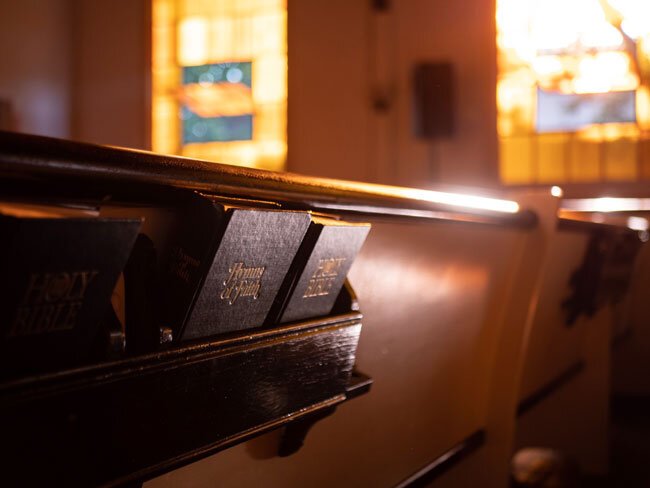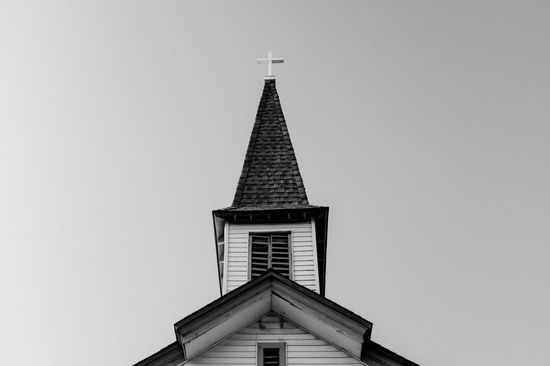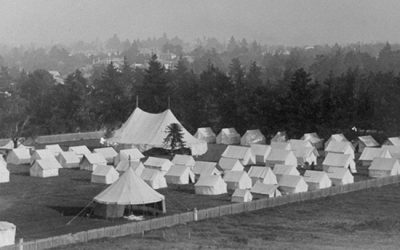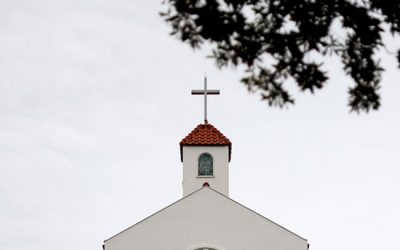If you’re attending an Adventist church for the first time, you may wonder what it’s really like. While each Adventist church is unique in its collective personality and local culture, Adventist church services are generally similar to most other Protestant church services.
While attending church isn’t supposed to be an intimidating experience, anytime you go somewhere new or meet new people can feel strange at first. To help you know what to expect, we’ll go over a few elements that are common to most Adventist churches, such as:
With churches all over the world, it’s likely you can find one near you.
At your local Adventist church, you’ll see people dressed nicely and starting the day off with Sabbath school. They’ll transition into the church service, complete with singing, praying, offerings, and a sermon. And at the end of it all is time to fellowship with each other.
So you know the general gist, but you may still wonder if going to church is even worth it. Will you like the service enough to go back or should you try out a different one?
It’s important to note that not every Adventist church service is structured the same. And that’s okay. But this is what your average Adventist church will look and feel like.
Just remember, whichever church or type of service you attend, the church is just a building. A church service is just a framework. All parts of the church and the service are human. And those parts are created to help us better serve God, study His Word, and encourage one another while we build community.
Regardless of how your first Sabbath goes, what matters most is that you chose to show up despite all the uncertainties. The details don’t matter near as much as growing a relationship with God. Because after all, isn’t that the whole point of church?
Arriving at church
Before you’re even inside the building—no service has started yet—you already have questions. What do I wear? Where do I go? What’s the order of service? Even though those are superficial questions about the church, they are nonetheless important and valid. And they are likely the main questions swirling around your mind.
Getting dressed for church

Photo by Ruthson Zimmerman on Unsplash
When going to an event, you want to dress appropriately, and church is no different. But here’s the tricky part: there’s no set dress code. This can be freeing but also not quite as helpful as specific guidelines.
A basic rule of thumb? Dress how you would if you were meeting someone special.
It’s completely up for interpretation, and collective church styles vary dramatically. Some members show up in slacks and blouses/button ups. Some opt for jeans and a nice shirt. Others wear their best dresses and suits.
You may see some people with jewelry, while others sport a more simple look. Some might have tattoos and piercings, while others don’t.
The decision to dress simply and naturally comes from the Bible—from wanting the focus to be more about the inside than the outside.
“Do not let your adorning be external—the braiding of hair and the putting on of gold jewelry, or the clothing you wear— but let your adorning be the hidden person of the heart with the imperishable beauty of a gentle and quiet spirit, which in God’s sight is very precious” (1 Peter 3:3-4, ESV).
And the heart of that message still applies today.
However, regardless of the way members and visitors are dressed, that isn’t the focal point—though sometimes it’s tempting to let that distract you. Just aim to be who you are, stick with your convictions, and maintain a humble mind. This will help you learn from what you observe, and give you the space to study God’s principles regarding this and other aspects. Then you can grow and settle in your convictions of what is appropriate to wear to church.
If matching the style of your local church helps you feel more comfortable, reach out to a member. If you know one, just ask. Or if you don’t, send a personal message to the church’s Facebook page. Or email the secretary through their website. You could even browse their social media accounts to look for pictures of the members at church.
Do what makes you comfortable, but remember, the focus is ultimately on God.
Finding your way inside
Now that you’re feeling confident enough to walk inside, you go. But what happens after that?
Look for someone with a friendly face and a stack of papers in their hands. They’re the greeters. They are there to help people like you find their way and feel comfortable and welcome.
The papers in their hands? Bulletins, the church programs with announcements and the order of service. Take one. Or even take two if you want to bring an extra home to your friend, mom, or brother!
If you don’t know where to go from there, ask the greeters. Depending on what time you arrive at church and which service times they have, greeters will likely direct you either to a room for Sabbath school or to the sanctuary for the morning service.
Sabbath school
An Adventist church experience is a lot like other Protestant churches, just with a little twist.
Church celebrations start with Sabbath school, a close cousin of Sunday school. The goal of Sabbath school is to break the congregation into age groups and create a space of learning and discussion.
Supplements to the Bible in many of these classes are the Sabbath school lesson books, which are created and produced by the Adventist church.
Three main categories make up the age groups: children, teens/young adults, and adults. While those are the main three, bigger churches break those up even more to keep the class size small enough for comfortable discussion. Through discussion, we can reason together and build each other up.
“Preach the word; be ready in season and out of season; reprove, rebuke, and exhort, with complete patience and teaching” (2 Timothy 4:2, ESV).
Children’s Sabbath school
This class is a favorite for children and parents alike. Instead of a discussion-focused “school time,” children’s Sabbath school is created to help kids get their wiggles out while learning about Jesus and stories from the Bible.
There are usually lots of singing with hand motions to match.
Then comes story time. Some Sabbath school teachers act out stories, while others may display the biblical scene on felt boards—boards where cloth characters and objects cling to the fabric and can be easily moved to continue the story. Whichever method is used, the stories are told in a way that is engaging and memorable for the children.
Churches that have time and resources may even have a craft for children to create: a whale craft for the story of Jonah, a banana-boat ark with animal crackers for Noah, or a paper-plate lion from the story of Daniel and the lions’ den. When kids leave Sabbath school with a craft in their hand, they have the opportunity to explain their craft to family and other members, which helps solidify the story in the kids’ minds.
Teen/Young adults
As children grow up, the classes grow with them, trading interactive hand motions for modern worship songs. The leaders of youth classes emphasize discussion and collaboration from participants, usually pertaining to age-appropriate struggles. Participation is never required, but discussing life through a Biblical lens helps attendees build a strong foundation in their faith.
For young Christians especially, the world is hard to navigate. Learning how to establish themselves in society without conforming to it is becoming increasingly difficult. These classes aim to help guide youth through these stages of life.
Young adults who attend these classes may have the opportunity to share their experiences with teens, and offer themselves as a kind, listening ear.
Adults
Adult classes have no specific age requirement. They tend to dig deeper into Biblical texts, using the Adventist-produced Sabbath school lessons as guides for Bible study and conversation.
If these stories/texts are new for you, these classes introduce the topic and provide ways you can study more about the topic.
However, if the text of the discussion is one you’ve heard before, odds are you’ll still learn something new. Because that’s the way God works; He’s continually teaching us.
“But the Advocate, the Holy Spirit, whom the Father will send in my name, will teach you all things and will remind you of everything I have said to you.” (John 14:26)
The Bible doesn’t get boring. You can never hear a story too much. You can never read a text too many times. The more you hear, the deeper you understand. The more you read, the more you learn. And in these classes, the more you discuss, the more grounded you’ll be in your faith.
The more you give to your class, the more you receive back.
These aren’t structured to be a listen and receive style. The topics are meant to be grappled with, discussed, and dissected. In the end, you’ll be challenged to think differently, explore more, and further develop your relationship with God.
Church service
Morning church service for the modern Adventist church is based on cultural tradition and backed by the Bible. The specific order of elements isn’t consistent everywhere, but generally it looks a little something like this:
A member steps up to the stage to welcome new and returning visitors. Sometimes they’ll invite everyone to stand and welcome people near them. But don’t let that intimidate you. It’s your chance to connect with a member, shake hands, and say “Happy Sabbath.” No pressure.
Song service
Then comes worship through song.
Worship through song is especially diverse among Adventist churches. Services can range from classical hymns to modern Christian praise songs. Feel free to try a few churches out until you find a worship style you connect with the most.
A leader (or leaders) will take the stage and guide the church through the songs, instructing whether to sit, stand, or kneel. If you don’t know the words, or for those of us who are forgetful, either use the Seventh-day Adventist Hymnal or look to the screens for lyrics.
Seventh-day Adventist Hymnal

Photo by Aaron Burden on Unsplash
You’ll likely find the Seventh-day Adventist Hymnal in the back of the pew in front of you. It is a compilation of Christian songs throughout the years, beginning in the year 1849. Through the decades since the first hymnal, there have been many additions and revisions.
The latest edition of the Seventh-day Adventist Hymnal was published by the Review and Herald—an Adventist publishing association—in 1985. This version is widely accepted today because of the large diversity of songs: some exclusive to Adventism, songs from other denominations, some gospel songs, African American spirituals, hymns for young worshipers, carols for Christmas, and others are all separated into topical categories.
Prayers, Scripture readings, and offerings
Next might come opening prayer, and whoever holds the microphone will likely let the church congregation know if they should stand or kneel.
Or maybe someone goes to the stand with a Bible, then it’s scripture time. The scripture for the day generally ties in with the pastor’s sermon.
Or a member goes to the front, talks about something called tithe, and asks the deacons to please stand. If you’ve never been to church, this could be confusing. What is tithe? Who are deacons? Am I a deacon?
No, you’ll want to stay seated for this part.
Tithe is a biblical term for returning money to God through the church. The understanding is that all we have is a gift from God—specifically money we have—and we should return 10% of our earnings to Him. This money goes to further the work of God through the church.
The deacons who stand in the front are members of the church who have signed up to be helpers of the church. They have decided to volunteer their time and service. And during tithes and offerings, they are the ones who pass around the offering plates where people place their tithe and offerings.
After the formal gathering of God’s funds comes the cute version: children’s offering. At this point, all the little ones in the church get a chance to stretch their legs and gather dollar bills and coins from members. Some kids are shy and need guidance from a parent, while others tear through the aisles with big smiles and open hands.
Once they’ve gathered all their little hands can carry, they take the money to the front offering box and settle in for the children’s story, a part of the service just for them.
The children get to sit in the front of the church and listen to a story from one of the members. Yes, the focus is on the children, but the storyteller has a microphone so everyone in the congregation can hear the mini, moral message.
After the kids learn something new, they’ll either be encouraged to return to their seats or be invited to children’s church—similar to children’s Sabbath school— in another part of the building. Wherever they are most comfortable, they are welcome.
While the children get settled, the pastor makes his way to the podium to preach the sermon for the day.
The Pastor’s sermon

Usually armed with a Bible and his notes, the pastor welcomes the congregation. He may comment on the weather, and offer a prayer before starting the sermon.
In Adventist churches, you’ll likely find a male pastor at the pulpit. Though, there are some churches with female pastors leading the congregation, and sometimes there’s even a guest speaker who may present the sermon for that day.
Sermons are the main messages prepared by the pastor and can last anywhere from 20-40 minutes (some longer than that, depending on the pastor). But since this is the staple of the church service, members are ready for the minister’s message, no matter how long.
But what is so special about the sermon?
Sermons are generally given by the church pastor, one who went to school to study God’s word. He spent years reading and rereading biblical stories. He likely took classes on sermon creation and studied Hebrew and Greek.
Though he has more training in biblical stories and understandings, he’s still human and no more holy than any other member.
But he is the one with the experience, so the church follows his lead. Much like how students follow a teacher. Teachers don’t know everything, but they are qualified in their subject, so students listen to learn more. It’s similar with pastors.
“Remember your leaders, who spoke the word of God to you. Consider the outcome of their way of life and imitate their faith” (Hebrews 13:7).
Whichever message the pastor brings, it’s meant to help the audience learn more about the character of God. It’s meant to get the audience thinking about something new or about something old in a new light.
As the church congregation listens to the pastor, some take notes—either by mentally storing away the question in their mind or by writing it down in a notebook or on Bible margins. Instead of interrupting the service with questions, these notes help remind listeners of thoughts or comments for later discussion.
After prayer and maybe a couple more songs, the service is over and that conversation can pick up in the fellowship hall.
Gathering for the fellowship meal
If you attend church on a week with a fellowship meal, or potluck, you’ll be invited to the fellowship hall to eat and mingle with other visitors and members.
This could also be your chance to meet the pastor. If you were one of those in the audience taking notes, now would be a good time to bring up your comments or questions, either with the pastor or another member.
At the fellowship meal, members of the church bring prepared dishes—generally vegetarian or vegan— to share with the whole church family and visitors. On these Sabbaths, not only are you spiritually fed from the church service, but you’re also fed physically.
“But He answered and said, ‘It is written, man shall not live by bread alone, but by every word that proceeds from the mouth of God’” (Matthew 4:4, NKJV).
But good food isn’t the point of the fellowship meal. The fellowship—the time to meet and mingle with others—is the purpose. And what better way to connect with people than over a meal?
Now’s your chance to meet someone new, to ask questions, to shake hands with the little girl who took your dollar bill to the offering box. There’s not much structure in the fellowship hall, so you get to talk with whoever you like, and eat what looks good.
Enjoy and come back next week!
The whole goal and focus of church is God.
You did it. You’ve successfully navigated through an Adventist church, Saturday service!
As you leave, please remember this: no church is perfect.
But through the imperfections of church, our imperfect humanity does its best to acknowledge, worship, and learn about an infinite, perfect God.
Sometimes it can be a temptation to make the church service itself what is worshiped, rather than God. And because we live in a sinful world, sometimes the focus might be shifted to fixate on ritualistic efforts. But remember the whole point is to put the focus on God.
Making God and our relationship with Him the goal is what matters most. Then as we put in the effort to be and do all in sincerity, that’s what makes church, church.
And remember, Jesus always promised to be with us as we meet together in worship when He said:
“For where two or three are gathered together in My name, I am there in the midst of them” (Matthew 18:20, NKJV).
Find a Church
If you’re interested in finding a local Adventist church near you, you can use the Adventist Locator provided by the General Conference of Seventh-day Adventists.
Related Articles
More Answers
Seventh-day Adventist World Population and Demographics
The Adventist Church has more than 22 million members and 100,000 churches worldwide, plus a large system of hospitals, schools, and publishing houses. Learn more about this diverse church.
What Is a Seventh-day Adventist Camp Meeting?
Although camp meetings didn’t begin with the Seventh-day Adventist Church, they’re as much an Adventist thing as haystacks.
Camp meeting is an extended event for Adventists (and non-Adventists) of all ages to gather and participate in spiritual seminars and activities. During the event, attendees often camp in tents, campers, or RVs.
How to Join the Seventh-day Adventist Church
Whether you heard about the Seventh-day Adventist Church through a traveling evangelist, during your online searches, or through a loved one or relative, you might be considering joining yourself.
How Do Adventists Do Baby Dedications?
For Christians, dedication ceremonies for babies, also for older children, are an important time for parents and the church. It’s a special part of the worship service when parents present their young children to God and the church family. Both parents, along with the congregation, regard this as a solemn promise to be a Christ-like example to the child.
Do Adventists Celebrate Communion and Foot Washing?
Like many Christian denominations, Adventists regularly participate in communion, also referred to as the “Lord’s Supper” or the “Last Supper.” They also practice foot washing (John 13:1-20), or the “ordinance of humility,” during the service—which isn’t as common.
What is the Concept of “Present Truth” and Why is it Important?
Present truth is the principle that certain biblical truths are relevant to God’s people at specific times in history. God sends the Holy Spirit to reveal truths that help us better understand how to interpret and apply His Word in a present moment.
Do Seventh-day Adventists Celebrate Easter
Yes, many Seventh-day Adventists do celebrate Easter.
Does the Adventist Church Have Youth Ministry Programs?
The Seventh-day Adventist Church has been organizing and operating youth ministry programs since 1879.
In our opinion, youth ministry is one of the most important ministries a church can have.
Do Adventists Celebrate Birthdays?
Yes, most Seventh-day Adventists do celebrate birthdays because we see them as excellent reminders of the life God has blessed us with. And we celebrate them the same way everyone else does—with friends, family, presents, and a special meal.
What Do Adventists Offer for Young Adults?
In recent years, the age group often classified as “young adults” has been trickier to engage. It’s been a significant concern for Christian churches around the world. Though interestingly enough, similar observations regarding young adults have been coming up in conversations about the economy, the entertainment industry, politics, and more.
Do I Need to be an Adventist to be Saved?
The answer to this question is simply, “no.”
When it comes to salvation in Jesus Christ, all that is required of a person is to acknowledge Jesus’ sacrifice for us, believe that He has saved us, and claim the free gift of salvation that is always available to us. Salvation is not based on denomination.
Do You Have to Be Vegetarian to Be Adventist?
Of course not. Membership in the Seventh-day Adventist Church has never included any dietary requirements. However, there might be some reasons people might think that. So many Adventists are vegetarians or even vegan, and a plant-based lifestyle has many health benefits.
All About Seventh-day Adventist Colporteurs
The Seventh-day Adventist Church uses a variety of methods to spread the hope of the gospel to the world. One of these ways is through colporteuring, also called “canvassing” or “literature evangelism.”
What Is an Adventist Book Center (ABC)?
When you walk into any one of the many Adventist Book Center (ABC) locations, chances are you’ll be greeted by pleasant gospel music in the background, friendly employees, and row after row of Christian books, movies, Bibles, study guides, kids’ games, and more.
Do Seventh-day Adventists Celebrate Holidays?
Wondering whether your Adventist classmate or coworker keeps the same holidays you do? Perhaps you want to include them in some festivities, but you also want to respect their beliefs. Thus, you’re unsure of how to navigate the holiday question. Will they accept your invitation to the office Christmas party?
The Adventist Haystack (It’s Not What You Think) + 4 Recipes
Haystacks are basically a taco salad—with an Adventist spin on it! Most versions are vegetarian and offer an endless combination of tasty toppings. We eat them often because they’re healthy, scrumptious, and easy to make.
Do Seventh-day Adventists Believe in Medical Care?
The Seventh-day Adventist Church believes in and supports evidence-based medical care. In fact, medicine has played a significant part in our history, and today we run a major health system with hospitals, medical schools, and clinics throughout the world.
All about Adventist Elementary Schools
The Seventh-day Adventist Church operates the largest Protestant education system in the world. A big part of this system is our K-8 elementary schools, or primary schools, as they’re known in other parts of the world.
What Are Pathfinder and Adventurer Clubs?
Like the boy or girl scouts, Pathfinders and Adventurers learn about nature and life skills. But what makes these clubs special is their purpose to bring young people closer to Jesus.
A Look at Adventist Colleges and Universities
On the outside, Seventh-day Adventist universities may not look much different than other college campuses. But the real differences are beneath the surface.
What Is ASI (Adventist-Laymen’s Services and Industries)?
ASI, which stands for Adventist-laymen’s Services and Industries, is a membership-based organization that provides support for Seventh-day Adventist laypeople (Adventist professionals who aren’t pastors).
What Are Adventist Evangelistic Meetings?
The Seventh-day Adventist Church puts a huge emphasis on sharing the gospel through evangelism, or sharing the gospel through preaching, teaching, and testimony. One of the ways we accomplish this is by organizing public events called evangelistic meetings.
Christian Summer Camps—A Cherished Adventist Ministry
School’s out, the sun’s shining, and your kids are thrilled to have the summer ahead of them. Then three days in, you hear, “I’m bored…”
Do Adventists Have Their Own Bible?
Adventists have some unique beliefs—you might be able to name some of them right now. The seventh-day Sabbath. Death as a sleep. Hell as nonexistence.
What Is Vespers?
Friday rolls around, and you’re spending time with your Adventist friends or relatives when they mention they’re going to vespers tonight.
Adventist Pastors
What is the role of a pastor in the Adventist Church? The position itself, at least as far as a local congregation is concerned, is not much different from that of pastors in other protestant denominations.
The Leadership Structure of the Seventh-day Adventist Church
The Seventh-day Adventist Church has a representative form of structure that connects its 90,000-plus congregations across the globe and gives its members a part in decision-making. Though the Church was incorporated in 1863, this system came about during the church’s reorganization from 1901 to 1903. It includes four levels of organization.
Adventist Education
Seventh-day Adventists have historically upheld the importance of a well-rounded, high-quality education. Instead of a one-size-fits-all approach to teaching and learning, the Adventist Education system operates on the principle of educating the “whole” person.
Evangelism
Evangelism is simply sharing the truths of the Bible with someone else. And Adventists are all into it.
Didn’t find your answer? Ask us!
We understand your concern of having questions but not knowing who to ask—we’ve felt it ourselves. When you’re ready to learn more about Adventists, send us a question! We know a thing or two about Adventists.


































